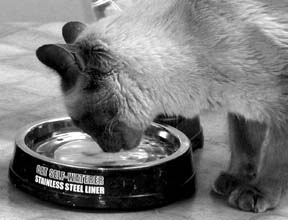
288
Its not a pretty picture. Your ladylike cat, Gardenia – a low-maintenance sort whos in the habit of defecating once a day – is hunched over in her litter box, clearly frustrated. She stares fixedly ahead, a look of grim determination in her eyes. As her abdomen pulsates and her entire body quakes, she lets out an agonized howl. She adjusts her position, crouches, and tries again – but without results. After a few more fruitless efforts to move her bowels, she gives up and ambles forlornly out of sight.
Gardenia is constipated. For some reason, her colon – the section of the intestine that functions as a reservoir for undigested food, bacteria and dead cells prior to its evacuation from the body – has become impacted with feces that simply wont budge. Or if they do, the yield is only a few hard, dark, and dry bits of pebbly stool.
This has been going on for a week, and you decide that its time for a visit to your veterinary clinic. A few days later, Gardenia is back home and into her old routine. And you consider yourself blessed to see – and smell – once again a firm, clearly defined stool in her litter box each evening.
Progressive Severity
Your vigilance has paid off, and Gardenia is the better for it. Some constipated cats are not so fortunate. Many owners will put off seeking veterinary help for weeks or even months, says Robert Washabau, VMD, a delay that can cause irreparable, perhaps life-threatening, damage to a cat.
According to Dr. Washabau, a professor of medicine at the University of Pennsylvanias School of Veterinary Medicine, colonic obstruction may occur in three progressively severe forms. The most common and least severe is constipation, which is generally treatable with enemas, medication and dietary adjustment. If untreated, the condition can proceed to obstipation, a more stubborn fecal impaction that may require prolonged hospitalization and more elaborate therapy – for example, manual removal of hardened fecal matter from an anesthetized cats colon. The most severe, end-stage form of constipation is megacolon, in which the colon becomes grossly dilated and unable to function properly. This condition could prove fatal without treatment, which may require surgical removal of part of the colon.
If a cat appears to be straining in order to defecate, says Dr. Washabau, or if shes yelping in pain while moving her bowels, the owner should consult a veterinarian as soon as possible. If the animal is completely unable to defecate, if it has lost its appetite, if it is vomiting, or if there is blood in its stool, you have an emergency situation, and veterinary help is needed without delay.
Overall, Dr. Washabau notes, about 75 percent of constipated cats do well after treatment. But, he adds, about 25 percent of the population are likely to have multiple recurrences due to colon damage. Over time, he says, this can become a real problem that calls for multiple veterinary visits.
Causes of Constipation
According to Dr. Washabau, constipation, obstipation and megacolon may be seen in cats of any age, sex or breed. Studies have shown, however, that most cases are observed in middle-aged cats (about six years old) and in male cats (70 percent of cases). Short-haired cats are three times more likely than long-haired cats to experience constipation. And Siamese cats appear to be more vulnerable than other breeds.
He dismisses the widely held notion that feline constipation is largely attributable to the presence of hairballs in an animals digestive tract, commenting that the scientific evidence for that is unconvincing. He likewise counters the view that dehydration is a key factor. A lack of water, says Dr. Washabau, can certainly worsen a case of constipation, but cannot, in itself, be considered a major cause.
In some cases, he says, constipation can stem from dietary inadequacy – especially a lack of fiber – and from certain medicinal side effects. Inability to defecate easily and routinely may also be caused by neurological conditions or from various disease processes, such as the development of an intestinal tumor.
In rare cases, constipation can result from disturbances in anal sphincter physiology, which makes defecation intolerably painful; from hormonal problems; from intestinal scars that affect the efficiency with which the smooth muscle lining the digestive tract moves its contents outward; or from the ingestion of foreign matter, such as string, bones, feathers or grass.
Of all known causes, says Dr. Washabau, the most common by far is damage to the pelvic bones resulting from trauma – when a cat is hit by an automobile, for example. This type of injury can narrow the bone structure in the pelvic area in such a way as to block the movement of fecal matter from the colon all the way out. About one-fourth of the constipation cases we see are due to pelvic fracture.
Diagnosis and Treatment
Diagnosing constipation is a comparatively simple matter, according to Dr. Washabau. It begins with abdominal palpation. We feel around the abdomen, he says, and along the entire length of the colon to see if it is distended with fecal matter and we observe whether theres any pain associated with the palpation. If the animal is constipated, you can tell right away. To follow up, we sometimes do X-rays or abdominal ultrasound. With an older cat, for example, we might be worried that there is a tumor causing the obstruction. This is uncommon in the colon, but it does occasionally occur – so X-rays and ultrasound would be needed.
Although dehydration is an infrequent cause of colonic obstruction, treatment will usually begin with measures to reduce its role as a contributing factor. First, well rehydrate the cat, and then well treat the animal with a warm-water enema, repeating the process as often as necessary to produce results, says Dr. Washabau. Sometimes, this can be done under mild sedation, but general anesthesia may be required. If warm water doesnt do the job, we may give enemas with lactulose. This is a synthetic sugar that makes the fecal matter more liquid and more readily defecated. We also may use motility agents or drugs that stimulate secretion in the colon.
These drugs may take two or three days to work, he says. In any case, the cat will not be released to its owners until the obstruction has cleared. Only when the animal defecates, says Dr. Washabau, is it ready to go home. The cost of diagnosis and treatment, he notes, is typically in the $200-to-$300 range; treatment for advanced and more complex cases will, of course, be more costly.
Preventing Obstruction
Several measures, Dr. Washabau advises, can help cat owners prevent their animals from experiencing constipation and its conceivably lethal consequences.
The following, he says, are most important:
Feed your cat a high-fiber diet. It doesnt really matter whether the food is dry or moist.
Make sure that the animal has ready access to a good supply of clean, fresh drinking water.
Keep the litter box well tended. If you allow feces to accumulate for days, the cat may avoid it. Shell defecate somewhere else or may decide to just hold it in.
If it is a multiple-cat household, the animal may refuse to use the litter box out of fear of a competitor. Its wise in such a case to use multiple litter boxes.
Above all, he urges, pay serious attention to your cats defecation habits and consult your veterinarian promptly if you notice any signs of the animals inability, difficulty or unwillingness to move its bowels.
A Special Concern
If you observe that your cat is ill at ease in its litter box – if not actually agonizing – you should be especially concerned if the animal is male. For one thing, says Dr. Robert Washabau, males are more than twice as likely than females to experience constipation. But thats not the only problem.
Males, he says, also have difficulties with urinary tract obstruction. This can produce the same signs as colonic obstruction, and it may be impossible for the owner to know whether the cat is straining to defecate or straining to urinate. In fact, the two problems can exist together. Unfortunately, if its a urinary obstruction, he could die from that – so its most important, especially for a male cat, that the owner report unusual litter-box behavior to a veterinarian right away.


